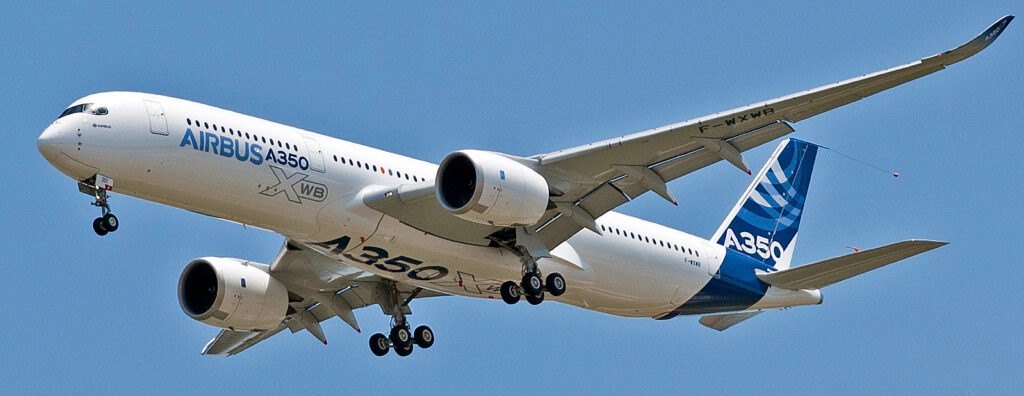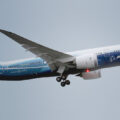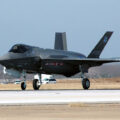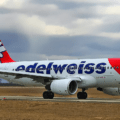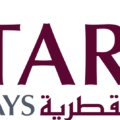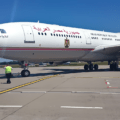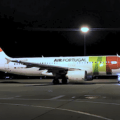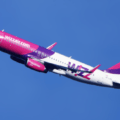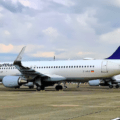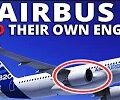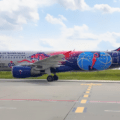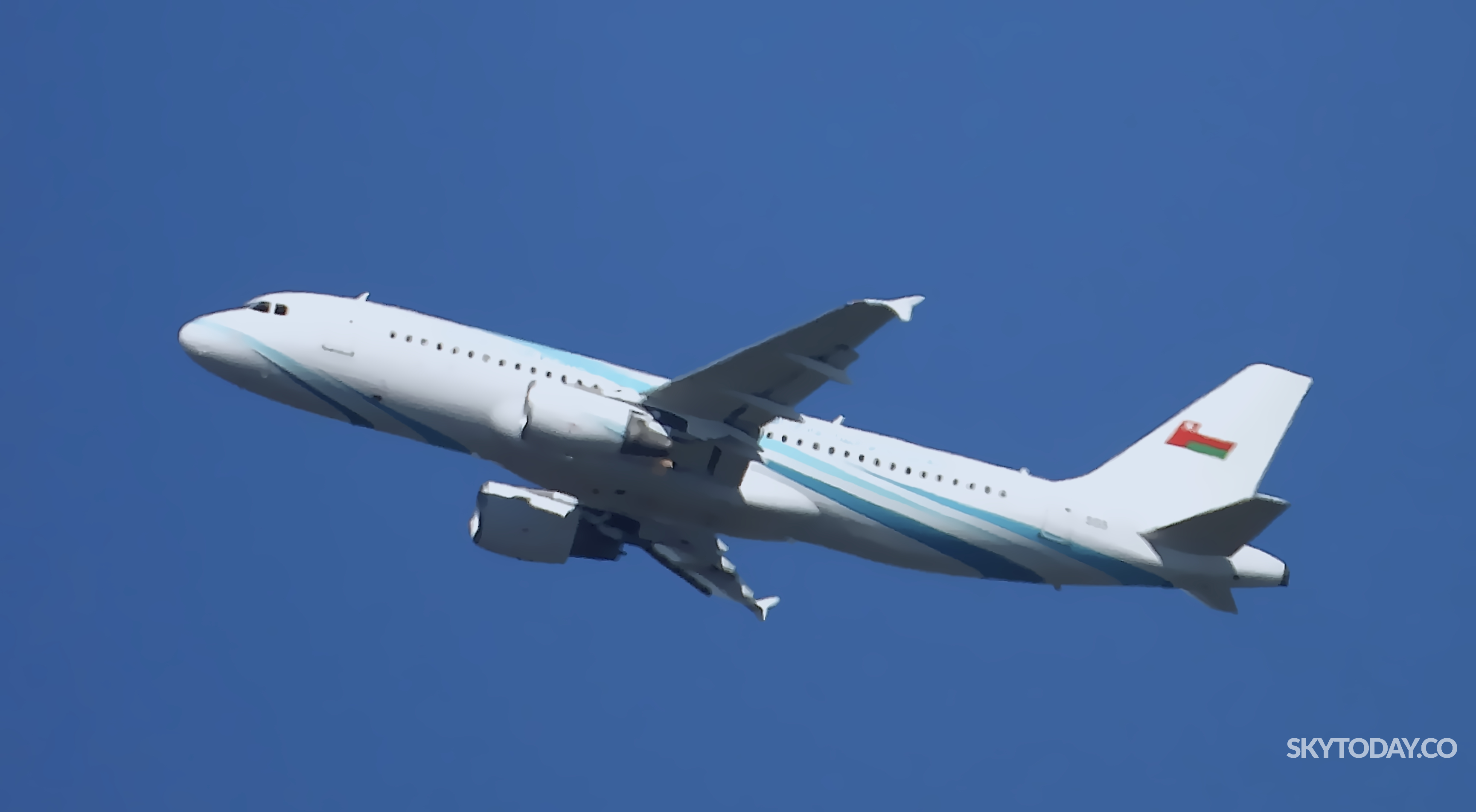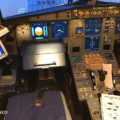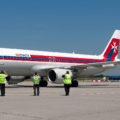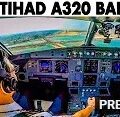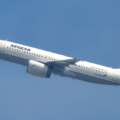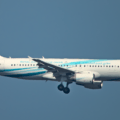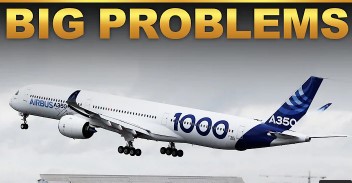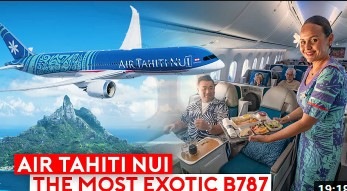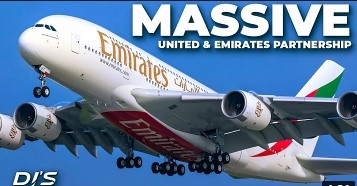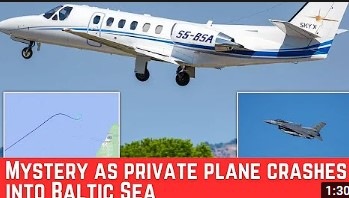Airbus
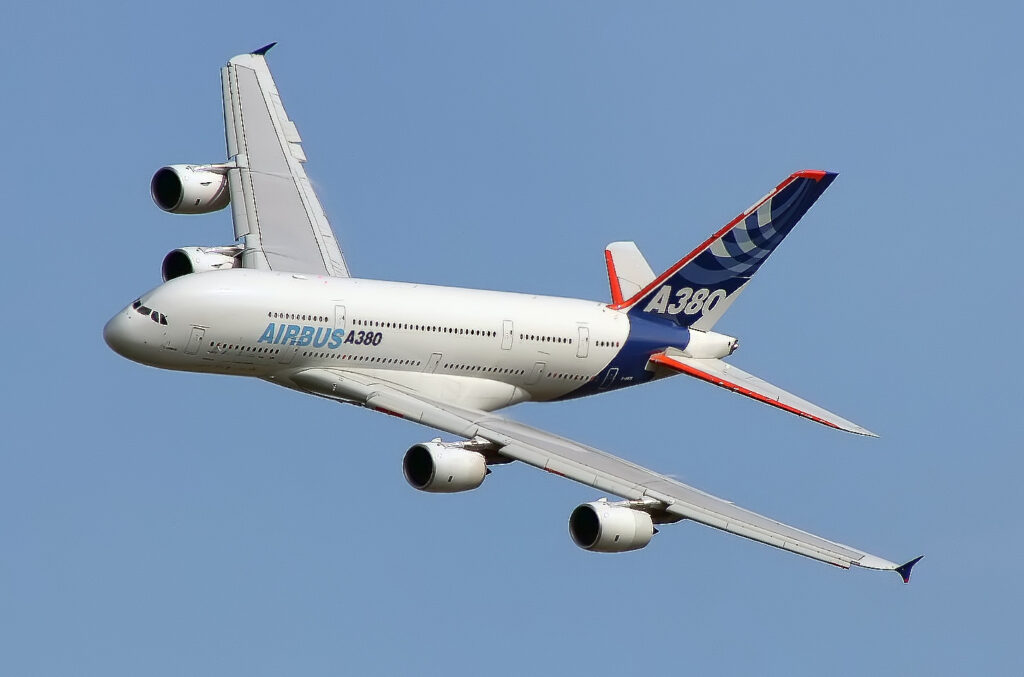
Source: Ienac from the German Wikipedia,
Airbus SE (/ˈɛərbʌs/; French: [ɛʁbys] (listen); German: [ˈɛːɐ̯bʊs] (listen); Spanish: [ˈejɾbus]) is a European multinational aerospace corporation. The ‘SE’ in the name refers to Societas Europaea, which enables it to be registered as European rather than Dutch. As of 2019, Airbus is the world’s largest airliner manufacturer and took the most airliner orders. Airbus is registered in the Netherlands; its shares are traded in France, Germany and Spain. It designs, manufactures and sells civil and military aerospace products worldwide and manufactures aircraft in the European Union and various other countries. The company has three divisions: Commercial Aircraft (Airbus S.A.S.), Defence and Space, and Helicopters, the third being the largest in its industry in terms of revenues and turbine helicopter deliveries.
The company’s main civil aeroplane business is conducted through the French company Airbus S.A.S., based in Blagnac, a suburb of Toulouse, with production and manufacturing facilities mostly in Europe (France, Germany, Spain, United Kingdom) but also in China, the United States and Canada. Final assembly production is based in Toulouse, France; Hamburg, Germany; Seville, Spain; Tianjin, China; Mobile, United States; and Montreal, Canada. The company produces and markets the first commercially viable digital fly-by-wire airliner, the Airbus A320, and the world’s largest passenger airliner, the A380. The 12,000th aircraft, an A220, was delivered to Delta Air Lines on 20 May 2019. By October 2016, the global Airbus fleet have performed more than 110 million flights, totalling over 215 billion kilometres and carrying 12 billion passengers.
Airbus’s registered headquarters is in Leiden, Netherlands, with the operating head office located in Toulouse.[16] The company is led by CEO Guillaume Faury and is a component of the Euro Stoxx 50 stock market index.

| Formerly | Parent company: European Aeronautic Defence and Space Company NV (2000–2014), Airbus Group NV (2014–2015), Airbus Group SE (2015–2017) Subsidiary: Airbus Industrie GIE (1970–2001), Airbus SAS (2001–today) |
|---|---|
| Type | Societas Europaea (SE) |
| Traded as | Euronext Paris: AIR BMAD: AIR FWB: AIR CAC 40 Component Euro Stoxx 50 component |
| ISIN | NL0000235190 |
| Industry | Aerospace, Defence |
| Predecessor | Aérospatiale-Matra, DASA, and CASA |
| Founded | 18 December 1970; 49 years ago (as Airbus Industrie GIE) |
| Founder | Roger Béteille, Felix Kracht, Henri Ziegler, Franz Josef Strauss |
| Headquarters | Blagnac, Greater Toulouse, France (main office) Leiden, Netherlands (headquarters) Madrid, Spain (international office) |
| Area served | Worldwide |
| Key people | René Obermann (Chairman) Guillaume Faury (CEO) |
| Products | Civilian A220, A300, A310, A318, A319, A320, A321, A330, A340, A350, A380 unmanned aerial vehicles |
| Revenue | |
| Operating income | |
| Net income | |
| Total assets | |
| Total equity | |
| Owner | As of 31 December 2019: SOGEPA (France): 11.0% GZBV (Germany): 10.9% SEPI (Spain): 4.1% Others: 74.0% |
| Number of employees | 133,671 (2018) |
| Divisions | Airbus Defence and Space SAS Airbus Helicopters SAS |
| Subsidiaries | Airbus S.A.S. Airbus Group, Inc. Airbus Corporate Jets Airbus Operations S.A.S. Navblue Stelia Aerospace Airbus Transport International Testia |
| Website | www.airbus.com |
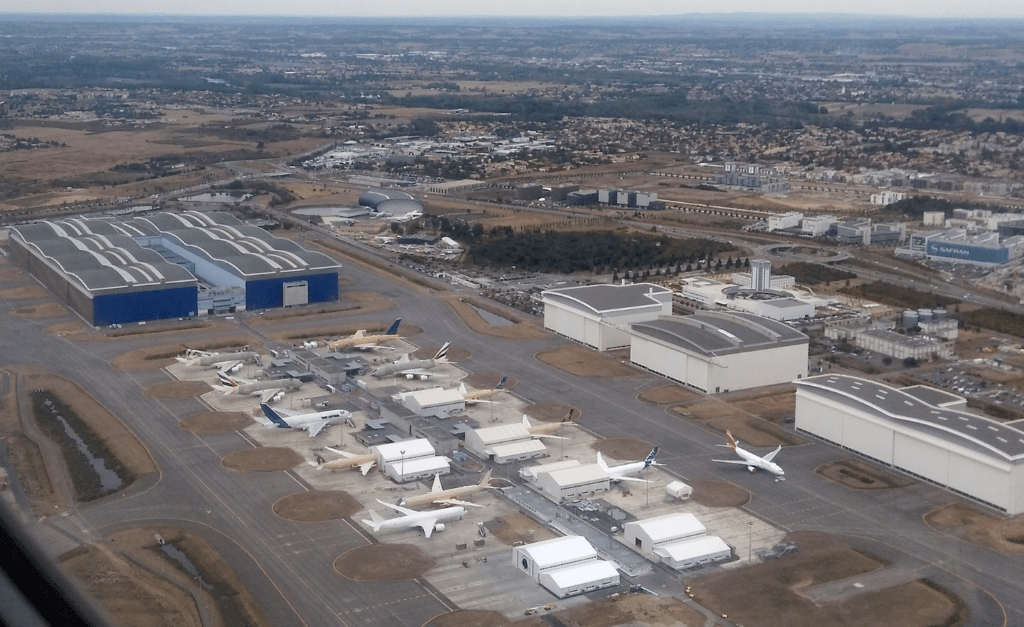
Source: Duch
History
The current company is the product of consolidation in the European aerospace industry tracing back to the formation of the Airbus Industrie GIE consortium in 1970. In 2000, the European Aeronautic Defence and Space Company (EADS) NV was established. In addition to other subsidiaries pertaining to security and space activities, EADS owned 100% of the pre-existing Eurocopter SA, established in 1992, as well as 80% of Airbus Industrie GIE. In 2001, Airbus Industrie GIE was reorganised as Airbus SAS, a simplified joint-stock company. In 2006, EADS acquired BAE Systems’s remaining 20% of Airbus. EADS NV was renamed Airbus Group NV and SE in 2014, and 2015, respectively. Due to the dominance of the Airbus SAS division within Airbus Group SE, the executive committees of the parent and subsidiary companies were aligned in January 2017, but the companies were kept as separate legal entities. The holding company was given its present name in April 2017.
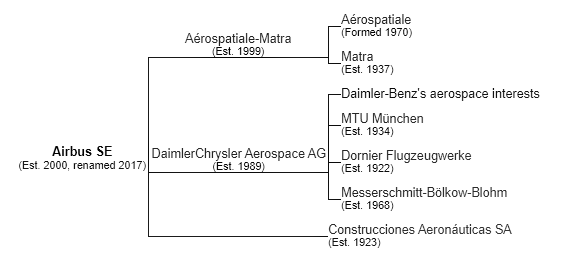
The logos of Airbus Industrie GIE and Airbus SAS displayed a stylised turbine symbol, redolent of a jet engine, and a font similar to Helvetica Black. The logo colours were reflected in the standard Airbus aircraft livery in each period. The EADS logo between 2000 and 2010 combined the logos of the merged companies, DaimlerChrysler Aerospace AG (a four-ray star) and Aérospatiale-Matra (a curved arrow), after which these elements were removed and a new font with 3D shading was chosen. This font was retained in the logos of Airbus Group NV (2014–2015) and Airbus Group SE (2015–2017), then Airbus SE:
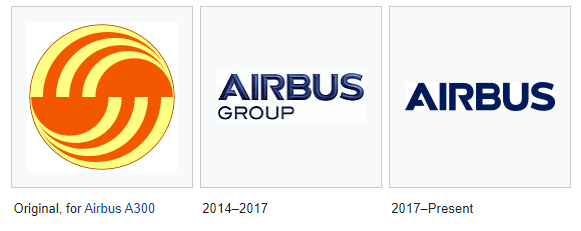
Products
Civilian
The Airbus product line started with the A300 in 1972, the world’s first twin-aisle, twin-engined aircraft. A shorter, re-winged, re-engined variant of the A300 is known as the A310.
Building on its success, Airbus launched the A320, particularly notable for being the first commercial jet to use a digital fly-by-wire control system. The A320 has been, and continues to be, a major commercial success. The A318 and A319 are shorter derivatives with some of the latter under construction for the corporate business jet market as Airbus Corporate Jets. A stretched version is known as the A321. The A320 family’s primary competitor is the Boeing 737 family.
The longer-range widebody products— the twin-jet A330 and the four-engine A340— have efficient wings, enhanced by winglets. The Airbus A340-500 has an operating range of 16,700 kilometres (9,000 nmi), the second longest range of any commercial jet after the Boeing 777-200LR (range of 17,446 km or 9,420 nautical miles).
All Airbus aircraft developed since then have cockpit systems similar to the A320, making it easier to train crew. Production of the four-engine A340 was ended in 2011 due to lack of sales compared to its twin-engine counterparts, such as the Boeing 777.
Airbus is studying a replacement for the A320 series, tentatively dubbed NSR, for “New Short-Range aircraft”.[25][26] Those studies indicated a maximum fuel efficiency gain of 9–10% for the NSR. Airbus however opted to enhance the existing A320 design using new winglets and working on aerodynamical improvements. This “A320 Enhanced” should have a fuel efficiency improvement of around 4–5%, shifting the launch of an A320 replacement to 2017–2018.
On 24 September 2009, the COO Fabrice Bregier stated to Le Figaro that the company would need from €800 million to €1 billion over six years to develop the new aircraft generation and preserve the company technological lead from new competitors like the Chinese Comac C919, scheduled to operate by 2015–2020.
In July 2007, Airbus delivered its last A300 to FedEx, marking the end of the A300/A310 production line. Airbus intends to relocate Toulouse A320 final assembly activity to Hamburg, and A350/A380 production in the opposite direction as part of its Power8 organisation plan begun under ex-CEO Christian Streiff.
Airbus supplied replacement parts and service for Concorde until its retirement in 2003.
Product list and details (date information from Airbus)
| Aircraft | Description | Seats | Max | 1st flight | Production ceased |
|---|---|---|---|---|---|
| A220 | 2 engines, single aisle, originally Bombardier CSeries | 108–130 | 133–160 | 2013-09-16 | |
| A300 | 2 engines, twin aisle | 228–254 | 361 | 1972-10-28 | 2007-03-27 (561 built) |
| A310 | 2 engines, twin aisle, modified A300 | 187 | 279 | 1982-04-03 | 2007-03-27 (255 built) |
| A318 | 2 engines, single aisle, shortened 6.17 m from A320 | 107 | 132 | 2002-01-15 | 2013-12-31 (80 built) |
| A319 | 2 engines, single aisle, shortened 3.77 m from A320 | 124 | 156 | 1995-08-25 | |
| A320 | 2 engines, single aisle | 150 | 186 | 1987-02-22 | |
| A321 | 2 engines, single aisle, lengthened 6.94 m from A320 | 185 | 240 | 1993-03-11 | |
| A330 | 2 engines, twin aisle | 246–300 | 406–440 | 1992-11-02 | |
| A340 | 4 engines, twin aisle | 239–380 | 380–440 | 1991-10-25 | 2011-11-10 (377 built) |
| A350 | 2 engines, twin aisle | 270–350 | 475 | 2013-06-14 | |
| A380 | 4 engines, double deck, twin aisle | 555 | 853 | 2005-04-27 | 2021 (planned) |
Airbus Corporate Jets markets and modifies new aircraft for private and corporate customers. It has a model range that parallels the commercial aircraft offered by the company, ranging from the A318 Elite to the double-deck Airbus A380 Prestige. Following the entry of the 737 based Boeing Business Jet, Airbus joined the business jet market with the A319 Corporate Jet in 1997. Although the term Airbus Corporate jet was initially used only for the A319CJ, it is now often used for all models, including the VIP widebodies. As of December 2008, 121 corporate and private jets are operating, 164 aircraft have been ordered, including an A380 Prestige and 107 A320 family Corporate Jet.
In September 2014, Aerion partnered with Airbus (mainly Airbus Defence) to collaborate on designing the Aerion AS2, a supersonic 11-seater private business jet, hoping for a market entry in 2021. Airbus was replaced with Lockheed Martin in 2017.
Consumer products
In June 2013, Airbus announced that it was developing a range of “smart suitcases” known as Bag2Go for air travellers, in conjunction with luggage-maker Rimowa and IT firm T-Systems. The cases feature a collection of built-in electronic gadgets which communicate with a smartphone app and with the IT systems of the airline, to assist the traveller and improve reliability and security of baggage handling. Gadgets include a weighing scale and a location tracker, using GPS for location tracking, RFID for identification, and a SIM card for messaging. Since then, similar products have been announced by other companies.
Military
In the late 1990s Airbus became increasingly interested in developing and selling to the military aviation market. It embarked on two main fields of development: aerial refuelling with the Airbus A310 MRTT (Multi-Role Tanker Transport) and the Airbus A330 MRTT, and tactical airlift with the Airbus A400M Atlas.

Source: Aergenium
In January 1999 Airbus established a separate company, Airbus Military SAS, to undertake development and production of a turboprop-powered tactical transport aircraft, the A400M. The A400M is being developed by several NATO members, Belgium, France, Germany, Luxembourg, Spain, Turkey, and the UK, as an alternative to relying on foreign aircraft for tactical airlift capacity, such as the Ukrainian Antonov An-124 Ruslan and the American C-130 Hercules. The A400M project has suffered several delays; Airbus has threatened to cancel the development unless it receives state subsidies.
Pakistan placed an order for the Airbus A310 MRTT in 2008, which will be a conversion of an existing airframe as the base model A310 is no longer in production. On 25 February 2008 Airbus won an order for three air refuelling MRTT aircraft, adapted from A330 passenger jets, from the United Arab Emirates. On 1 March 2008 a consortium of Airbus and Northrop Grumman had won a $35 billion contract to build the new in-flight refuelling aircraft KC-45A, a US built version of the MRTT, for the USAF. The decision drew a formal complaint from Boeing, and the KC-X contract was cancelled to begin bidding afresh.
Airbus aircraft numbering system
The Airbus numbering system is an alpha numeric model number followed by a dash and a three digit number.
The model number often takes the form of the letter “A” followed by a ‘3’, a digit, then followed normally by a ‘0’, for example A350. There are some exceptions such as: A220, A318, A319, A321 and A400M. The succeeding three digit number represents the aircraft series, the engine manufacturer and engine version number respectively. To use an A380-800 with Engine Alliance (EA) GP7200 engines as an example; The code is 8 for series 800, 6 for Engine Alliance and engine version 1, thus the aircraft number is A380-861.
An additional letter is sometimes used. These include, ‘C’ for a combi version (passenger/freighter), ‘F’ for a freighter model, ‘R’ for the long range model, and ‘X’ for the enhanced model.
The typical Airbus numbering system does not apply to the A220, therefore it would be incorrect to label an A220-300 as “A220-371”.
Engine codes
| Code | Manufacturing company |
|---|---|
| 0 | General Electric (GE) |
| 1 | CFM International (GE and SNECMA, now a subsidiary of Safran) |
| 2 | Pratt & Whitney (P&W) |
| 3 | International Aero Engines (P&W, R-R, MTU, Kawasaki, Mitsubishi, and IHI) |
| 4 | Rolls-Royce (R-R) |
| 5 | CFM International (GE and SNECMA/Safran) (CFM International LEAP-1A for A320 NEO Family) |
| 6 | Engine Alliance (GE and P&W) |
| 7 | Pratt & Whitney (P&W) (Pratt & Whitney PW1100G for A320 NEO) |
Orders and deliveries
| Aircraft | Orders | Deliveries | In operation | Unfilled |
|---|---|---|---|---|
| A220 | 658 | 111 | 111 | 547 |
| A300 | 561 | 561 | 235 | — |
| A310 | 255 | 255 | 65 | — |
| A320ceo* | 8,127 | 8,065 | 7,602 | 62 |
| A320neo* | 7,395 | 1,248 | 1,248 | 6,147 |
| A330ceo* | 1,486 | 1,449 | 1,394 | 37 |
| A330neo* | 337 | 46 | 46 | 291 |
| A340* | 377 | 377 | 236 | — |
| A350* | 935 | 358 | 358 | 577 |
| A380 | 251 | 242 | 240 | 9 |
| Total | 20,382 | 12,712 | 11,535 | 7,670 |
* All models included.
Data as of 29 February 2020.

Source: David Monniaux
Organisation
Divisions
Commercial aircraft
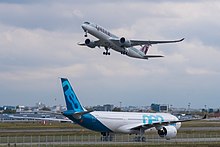
Source: Alex Cheban
Commercial aircraft generated 66% of total revenue for the group in 2013. The product portfolio of such aircraft encompasses short range models such as the A320 family and the world’s largest passenger airliner, the A380.
- EADS Sogerma
- Airbus Executive and Private Aviation
Airbus Transport International
Airbus Transport International is a cargo airline that operates a fleet of five Airbus Beluga aircraft. The belugas carry aircraft parts from factories to final assembly lines. In 2020, three Airbus Beluga XL aircraft which can carry two A350 wings rather than one Airbus A350 wing. These will slowly replace the five original belugas in the coming years.
Defence and space
The division Airbus Defence and Space was formed in January 2014 as part of the group restructuring from the former EADS divisions Airbus Military, Astrium, and Cassidian (composed of Cassidian Electronics – develops and manufactures sensors, radars, avionics and electronic warfare systems for military and security applications, Cassidian Air Systems – develops manned and unmanned aerial systems (UAVs), mission avionics, electronic defence and warning systems and Cassidian Systems – provides global security systems such as command & control, lead system integration, TETRA and TETRAPOL communication systems for public safety, industry, transportation and defence. This line of business was the first one in the world to begin field tests with TETRA Enhanced Data Service (TEDS).
- EADS 3 Sigma – a Hellenic company focused in the design, development, production and services provision of airborne and surface target drone systems.
The Airbus Military division, which manufactured tanker, transport and mission aircraft; Eurocopter, the world’s largest helicopter supplier; Astrium, provided systems for aerial, land, naval and civilian security applications including Ariane, Galileo and Cassidian. Through Cassidian, EADS was a partner in the Eurofighter consortium as well as in the missile systems provider MBDA.
Helicopters
Airbus Helicopters, formerly known as Eurocopter, is a helicopter manufacturing and support company. See also: Airbus Helicopters, Inc.
Subsidiaries
- Airbus APWorks
- AirBusiness Academy
- Airbus Group, Inc. – (previously EADS North America) the U.S. holding company for the North American activities of Airbus Group
- Airbus Transport International – Cargo Airline managing the transportation of Airbus parts between different facilities.
- APSYS
- CRISA
- Dornier Consulting
- NAVBLUE
- Premium AEROTEC
- Satair
- Stelia Aerospace
- Testia
Joint ventures
| Name | Holding | Description |
|---|---|---|
| Airbus Canada Limited Partnership | 75% | manufacturer of Airbus A220 aircraft |
| ArianeGroup | 50% | manufacturer of Ariane 5 and Ariane 6 launch vehicles |
| Arianespace | 30% | launch service provider |
| ATR | 50% | manufacturer of ATR 42 and ATR 72 regional aircraft |
| Dassault Aviation | 10% | manufacturer of Dassault Rafale and Dassault Mirage 2000 |
| Eurofighter GmbH | 46% | manufacturer of Eurofighter Typhoon |
| MBDA | 37.5% | develops and manufactures missiles |
In September 2014 Airbus considered divesting Dassault and several other units to focus on aerospace. They reduced their shareholding in Dassault Aviation to 10% by the end of 2016.

Source: Staro1
Governance
The corporate management of the Airbus SE as of April 2019:
Chief Executive Officer: Guillaume Faury
Executive Committee:
| Member | Title |
|---|---|
| Dominik Asam | Chief Financial Officer |
| Thierry Baril | Chief Human Resources Officer |
| Jean-Brice Dumont | Executive Vice President Engineering |
| Bruno Even | Chief Executive Officer Airbus Helicopters |
| John Harrison | General Counsel |
| Dirk Hoke | Chief Executive Officer Airbus Defence and Space |
| Julie Kitcher | Executive Vice President Communications and Corporate Affairs |
| Philippe Mhun | Executive Vice President Programmes and Services |
| Christian Scherer | Chief Commercial Officer |
| Michael Schöllhorn | Chief Operations Officer |
| Grazia Vittadini | Chief Technology Officer |
Corporate affairs
The subsidiary Airbus Middle East is headquartered in the Dubai Airport Free Zone.[72] This subsidiary opened in 2006.
The subsidiary Airbus Japan K.K. (エアバス・ジャパン株式会社) is headquartered in the Roppongi Hills Mori Tower in Roppongi, Minato, Tokyo.
International manufacturing presence
Airbus has several final assembly lines for different models and markets. These are:
- Toulouse, France (A320, A330 family, A350 family and A380)
- Hamburg, Germany (A318, A319, A320 and A321)
- Seville, Spain (A400M)
- Tianjin, China (A319 and A320).
- Mobile, Alabama, USA — Airbus Mobile (A319, A320 and A321)
- Mirabel, Canada (A220)
Airbus, however, has a number of other plants in different European locations, reflecting its foundation as a consortium. An original solution to the problem of moving aircraft parts between the different factories and the assembly plants is the use of the Airbus Beluga, a modified cargo aircraft capable of carrying entire sections of fuselage. Boeing adopted a similar solution with 4 adapted 747-400s to transport the components of the 787. An exception to this scheme is the A380, whose fuselage and wings are too large for sections to be carried by the Beluga. Large A380 parts are brought by ship to Bordeaux, and then transported to the Toulouse assembly plant by the Itinéraire à Grand Gabarit, a specially enlarged waterway and road route.
Airbus opened an assembly plant in Tianjin, People’s Republic of China for its A320 series airliners in 2009.[76][77][78] Airbus started constructing a $350 million component manufacturing plant in Harbin, China in July 2009, which will employ 1,000 people. Scheduled to be operated by the end of 2010, the 30,000 square metre plant will manufacture composite parts and assemble composite work-packages for the A350 XWB, A320 families and future Airbus programmes. Harbin Aircraft Industry Group Corporation, Hafei Aviation Industry Company Ltd, AviChina Industry & Technology Company and other Chinese partners hold the 80% stake of the plant while Airbus control the remaining 20%.
North America is an important region to Airbus in terms of both aircraft sales and suppliers. 2,000 of the total of approximately 5,300 Airbus jetliners sold by Airbus around the world, representing every aircraft in its product line from the 107-seat A318 to the 565-passenger A380, are ordered by North American customers. According to Airbus, US contractors, supporting an estimated 120,000 jobs, earned an estimated $5.5 billion (2003) worth of business. For example, one version of the A380 has 51% American content in terms of work share value.
Plans for a Mobile, Alabama aircraft assembly plant were unveiled by Airbus CEO Fabrice Brégier from the Mobile Convention Centre on 2 July 2012. The plans include a $600 million factory at the Mobile Aeroplex at Brookley for the assembly of the A220, A319, A320 and A321 aircraft. It could employ up to 1,000 full-time workers when operational. Construction began on 8 April 2013, and became operable by 2015, producing up to 50 aircraft per year by 2017.
In February 2019, Airbus stated that production of the A380 will end in 2021 after Emirates, the biggest customer for the plane, reduced its outstanding order for 53 planes to just fourteen.

Source: WIKIBERTO
Financial information
In October 2005 the British Ministry of Defence warned European politicians to stop, as it sees it, interfering in the corporate governance of EADS. The former UK Defence Procurement Minister Lord Drayson hinted that the UK government, a major customer for EADS, may withhold future contracts. “As a key customer, we see it as important for EADS to move in a direction that is free from political interference.”
On 4 April 2006, DaimlerChrysler announced its intention to reduce its shareholding from 30 % to 22.5 %. The company places a value of the stake at “approximately €2.0 billion.” Lagardère will reduce its holding by an identical amount. However, Caisse des Dépôts et Consignations, a unit of the French government, acquired 2.25 % of EADS. At issue as a result is the fact that the German and French shareholdings are now in imbalance.
On 30 August 2006, shortly after the stock price decline caused by the A380 delivery delays, more than 5 % of EADS stock has been reportedly purchased by the Russian state-owned Vneshtorgbank. Now its share is nearly 6 %. In December 2007, Vneshtorgbank sold EADS shares to another state-controlled bank Vneshekonombank. EADS sharers are to be delivered by Vneshekonombank to the charter capital of JSC “United Aircraft Corporation” in 2008.
On 3 October 2006, shortly after EADS admitted further delays in the Airbus 380 programme would cost the company 4.8 billion euros in lost earnings in 2010, EADS shares, traded on the Paris arm of Euronext, were suspended after they surpassed the 10 % loss limit. Trading resumed later in the day with the one-day loss holding at 7 %.
In 2007, Dubai Holding acquired 3.12 % of EADS stock, making the Dubai buy-out fund one of the largest institutional shareholders.
In 2008, EADS had arms sales equivalent of $17.9 billion, which constituted 28 % of total revenue.
In April 2013, Daimler sold its shares in EADS.
As of 22 June 2018, 73.6 % of Airbus Group stock is publicly traded on six European stock exchanges, while the remaining 26.4 % is owned by a “Contractual Partnership”. As at 26 April 2018, the partnership is owned by SOGEPA (11.1%), GZBV (11.1%) and SEPI (4.2%). SOGEPA is owned by the French State, GZBV is majority owned by KfW, while SEPI is a Spanish state holding company.
In April 2020, Airbus announced that it has cut aircraft production by a third due to the Covid-19 outbreak. According to Guillaume Faury, the company was “bleeding cash at an unprecedented speed.” The recession put its survival at stake and presented the need for deep job cuts throughout all Airbus departments. 3,000 workers in France were involved in government-assisted furlough schemes.
| Finances | 2013 | 2012 | 2011 | 2010 | 2009 | 2008 | 2007 | 2006 | 2005 | 2004 |
|---|---|---|---|---|---|---|---|---|---|---|
| Sales EUR billion | 59.256 | 56.480 | 49.128 | 45.752 | 42.822 | 43.265 | 39.123 | 39.434 | 34.206 | 31.761 |
| EBITDA in Mio. EUR | 4.575 | 4.142 | 3.473 | 2.769 | 1.446 | 4.439 | 1.751 | 2.033 | 4.365 | 3.841 |
| EBIT in Mio. EUR | 2.661 | 2.186 | 1.696 | 1.231 | (322) | 2.830 | 52 | 399 | 2.852 | 2.432 |
| Research and development costs EUR million | 3.160 | 3.142 | 3.152 | 2.939 | 2.825 | 2.669 | 2.608 | 2.458 | 2.075 | 2.126 |
| Consolidated net income EUR million | 1.465 | 1.198 | 1.104 | 584 | (722) | 1.613 | (433) | 199 | 1.769 | 1.342 |
| Earnings per share in EUR | 1,85 | 1,46 | 1,27 | 0,68 | (0,94) | 1,95 | (0,56) | 0,12 | 2,11 | 1,50 |
| Dividend per share in EUR | 0,75 | 0,60 | 0,45 | 0,22 | 0,00 | 0,20 | 0,12 | 0,12 | 0,65 | 0,50 |
| Free cash flow in EUR million | (818) | 3.472 | 958 | 2.707 | 585 | 2.559 | 3.354 | 2.029 | 2.413 | 1.614 |
| New orders in EUR million | 218.681 | 102.471 | 131.027 | 83.147 | 45.847 | 98.648 | 136.799 | 69.018 | 92.551 | 44.117 |
| Order backlog at 31.12. in EUR million | 686.734 | 566.463 | 540.978 | 448.493 | 389.067 | 400.248 | 339.532 | 262.810 | 253.235 | 184.288 |
| Employees (number) 31.12. | 144.061 | 140.405 | 133.115 | 121.691 | 119.506 | 118.349 | 116.493 | 116.805 | 113.210 | 110.662 |
| accounted for under IFRS; The fiscal year ends on 31/12. |
Sales of military equipment in 2012 amounted to 15.4 billion US dollars.

Source: Terence Ong, derivative work Lämpel
Environmental record
Airbus has committed to the “Flightpath 2050”, an aviation industry plan to reduce noise, CO2, and NOx emissions.
Airbus was the first aerospace business to become ISO 14001 certified, in January 2007; this is a broader certification covering the whole organisation, not just the aircraft it produces.
In association with Honeywell and JetBlue Airbus has developed a biofuel to reduce pollution and dependence on fossil fuels, claiming that this has the potential to replace up to a third of the world’s aviation fuel. Algae-based biofuel absorbs carbon dioxide during growth and does not compete with food production. This alternative may be commercially available by 2030 but algae and other vegetation-based fuels are in an early stage of development and fuel-bearing algae has been expensive to develop.[103] Airbus offers delivery flights to airlines using a 10% biofuel blend in standard engines. The fuel does not cut carbon emissions but is free of sulphur emissions and demonstrates that the fuel could be used in commercial flights in unmodified engines.
Controversies
Government subsidies
Boeing has continually protested over “launch aid” and other forms of government aid to Airbus, while Airbus has argued that Boeing receives illegal subsidies through military and research contracts and tax breaks.
In July 2004 former Boeing CEO Harry Stonecipher accused Airbus of abusing a 1992 bilateral EU-US agreement providing for disciplines for large civil aircraft support from governments. Airbus is given reimbursable launch investment (RLI), called “launch aid” by the US, from European governments with the money being paid back with interest plus indefinite royalties, but only if the aircraft is a commercial success. Airbus contends that this system is fully compliant with the 1992 agreement and WTO rules. The agreement allows up to 33% of the programme cost to be met through government loans which are to be fully repaid within 17 years with interest and royalties. These loans are held at a minimum interest rate equal to the cost of government borrowing plus 0.25%, which would be below market rates available to Airbus without government support. Airbus claims that since the signature of the EU-US agreement in 1992, it has repaid European governments more than U.S.$6.7 billion and that this is 40% more than it has received.
Airbus argues that the military contracts awarded to Boeing, the second largest U.S. defence contractor, are in effect a form of subsidy, such as the controversy surrounding the Boeing KC-767 military contracting arrangements. The significant U.S. government support of technology development via NASA also provides significant support to Boeing, as do the large tax breaks offered to Boeing, which some people claim are in violation of the 1992 agreement and WTO rules. In its recent products such as the 787, Boeing has also been offered direct financial support from local and state governments.
In January 2005 the European Union and United States trade representatives, Peter Mandelson and Robert Zoellick respectively, agreed to talks aimed at resolving the increasing tensions. These talks were not successful with the dispute becoming more acrimonious rather than approaching a settlement.
WTO ruled in August 2010 and in May 2011 that Airbus had received improper government subsidies through loans with below market rates from several European countries. In a separate ruling in February 2011, WTO found that Boeing had received local and federal aid in violation of WTO rules.
Cluster bomb allegation
In 2005 the Government Pension Fund of Norway recommended the exclusion of several companies producing cluster bombs or components. EADS and its sister company EADS Finance BV were among them, arguing that EADS manufactures “key components for cluster bombs”. The criticism was centred around TDA, a joint venture between EADS and Thales S.A. TDA produced the mortar ammunition PR Cargo, which can be considered cluster ammunition, however this definition has since been successfully battled by EADS. EADS and its subsidiaries are now regarded as fulfilling all the conditions of the Ottawa Treaty. According to the new point of view, no product of EADS or its subsidiaries falls into the category of antipersonnel mines as defined by the Ottawa Treaty (“landmines under the Ottawa Treaty”). In April 2006, the fund declared that the basis for excluding EADS from investments related to production of cluster munitions is no longer valid, however its shareholding of MBDA means the fund still excludes EADS due to its indirect involvement in nuclear weapons production.
Insider trading investigation
On 2 June 2006 co-CEO Noël Forgeard and Airbus CEO Gustav Humbert resigned following the controversy caused by the June 2006 announcement that deliveries of the A380 would be delayed by a further six months. Forgeard was one of a number of executives including Jean-Paul Gut who exercised stock options in November 2005 and March 2006. He and twenty-one other executives are under investigation as to whether they knew about the delays in the Airbus A380 project which caused a 26 % fall in EADS shares when publicised. The French government’s actions were also under investigation; The state-owned bank Caisse des Dépots et Consignations (CDC) bought part of Lagardère’s 7.5 % stake in EADS in April 2006, allowing that latter to partially escape the June 2006 losses.

Source: Adrian Pingstone (Arpingstone), derivative work Lämpel
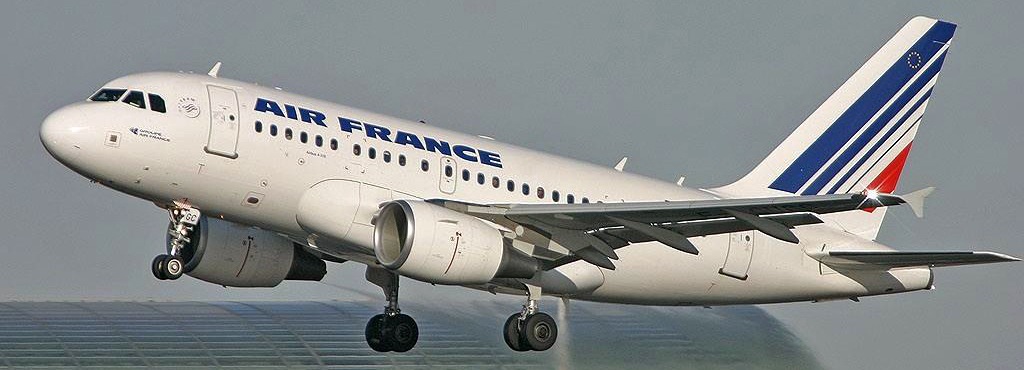
Source: Philippe Noret – AirTeamimages
Bribery allegations
South Africa
In 2003 Tony Yengeni, former chief whip of South Africa’s African National Congress, was convicted of fraud worth around USD5 billion relating to an arms deal with South Africa, in which Airbus (formerly EADS) were major players,. It was claimed that Airbus had admitted that it had “rendered assistance” to around thirty senior officials, including defence force chief General Siphiwe Nyanda, to obtain luxury vehicles. In March 2003, South Africa withdrew all charges of bribery against the former head of EADS South Africa, and in September 2004, the prosecutor’s office dismissed the bribery charges against Yengeni.
Saudi Arabia
In August 2012 the UK’s Serious Fraud Office opened a criminal investigation into an EADS subsidiary, GPT Special Project Management Ltd, regarding bribery allegations made by GPT’s former programme director, Ian Foxley. Foxley alleged that luxury cars were bought for senior Saudis, and that millions of pounds sterling were paid to mysterious Cayman Islands companies, possibly to secure a £2 billion contract to renew the Saudi Arabian National Guard’s military telecommunications network. Foxley’s allegations were supported by two other GPT employees. The later agreement between Airbus and the SFO on 31 January 2020 excluded settlement of this case.
British and French investigations
The French National Financial Prosecutor’s Office (PNF), the UK Serious Fraud Office (SFO) and the US Department of Justice (DoJ) had been jointly investigating irregularities in Airbus marketing practices since 2016, in particular the activities of agents Saudi Arabia, Kazakhstan, the Philippines, Indonesia and Austria, but also China, the United Arab Emirates, South Korea, Japan, Saudi Arabia, Taiwan, Kuwait, Turkey, Russia, Mexico, Brazil, Vietnam, India, Colombia and Nepal.
In July 2016, SFO opened a criminal investigation into “suspicions of fraud, bribes and corruption” after Airbus informed British authorities of a failure to disclose the role played by some intermediaries facilitating the sale of aircraft. Airbus was required to provide this information in order to benefit from export credits, which the British, French and German governments had suspended. In March 2017, the PNF subsequently opened a preliminary investigation into “suspicions of fraud and corruption in civil aviation activities” in cooperation with the SFO.
The allegations included that from 2012 onwards Airbus was responsible for recruiting and remunerating intermediaries to influence the award of civil and military contracts. Payments worth hundreds of millions of euros in alleged secret commissions were made and numerous sales including in Saudi Arabia, Kazakhstan, Philippines, Indonesia, Austria, China and Mauritius were under suspicion of bribery.
The investigation focussed on the Airbus, Strategy and Marketing Organization (SMO), the department responsible for negotiating sales contracts and which, La Tribune reported as having “a network and an incredible influence around the world.” Directed successively by Jean-Paul Gut and Marwan Lahoud, the SMO was dissolved in 2016 under the new executive director, Thomas Enders, as part of a “clean hands” operation.
In 2014, in a case referred to as the Kazakhgate affair, a search at Airbus Helicopters by French authorities found emails confirming that Airbus had agreed in principle to pay €12 million in pots of wine to the Prime Minister of Kazakhstan to facilitate the sale of helicopters. Officers from the Central Anti-Corruption Office (OCLCIFF) then searched the home of Marwan Lahoud on 8 February, 2016. This revealed that two Turkish intermediaries had claimed payment of commissions due in connection with the sale of 160 aircraft to China valued at USD10 billion. A message by Lahoud suggested that the commissions could reach USD250 million. The SMO was to conceal these commissions as false invoices for a fictitious Caspian pipeline project.
In January 2020, French, British and American courts validated three agreements between Airbus and the PNF, the UK SFO,[ and the US DoJ. Airbus recognised the charges and agreed to pay fines of €3.6 billion in France, €984 million in the United Kingdom and €526 million in the United States. The penalties were the highest ever issued by the French and British bodies.
These settlements close the prosecution of Airbus regarding the Kazakhstan case but not allegations of misconduct in Saudi Arabia, China and Turkey, which Airbus denies.Airbus managers may still be pursued as private individuals.
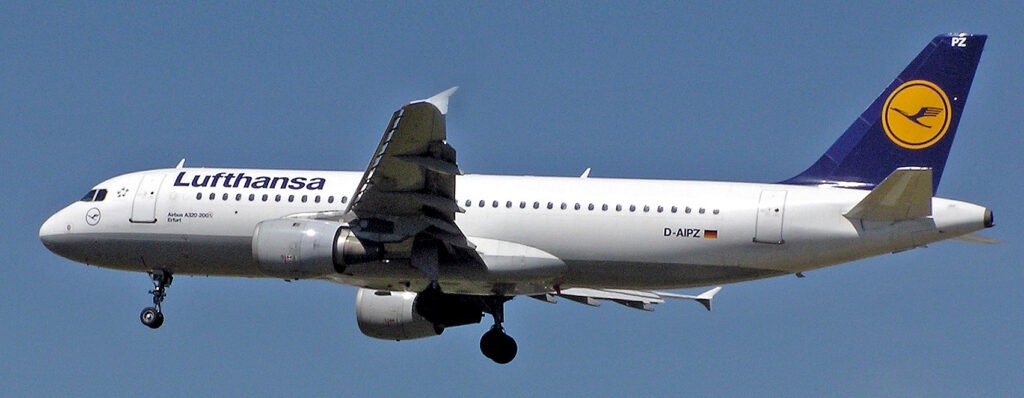
Source: Adrian Pingstone, derivative work Lämpel
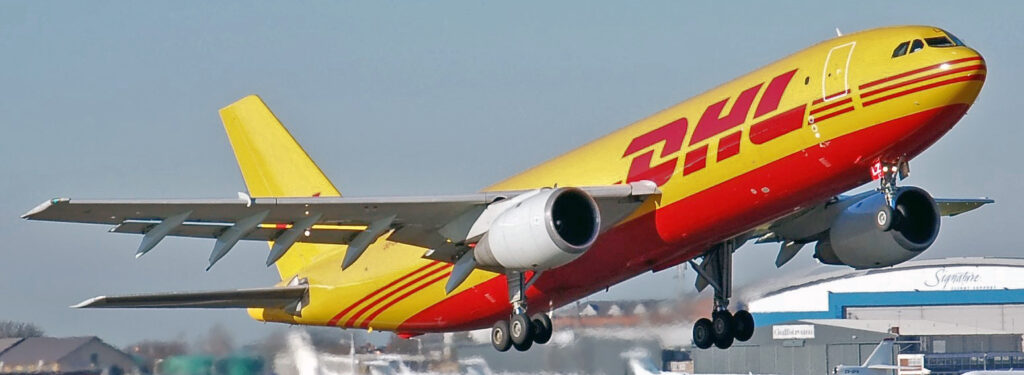
Source: Adrian Pingstone, derivative work Lämpel
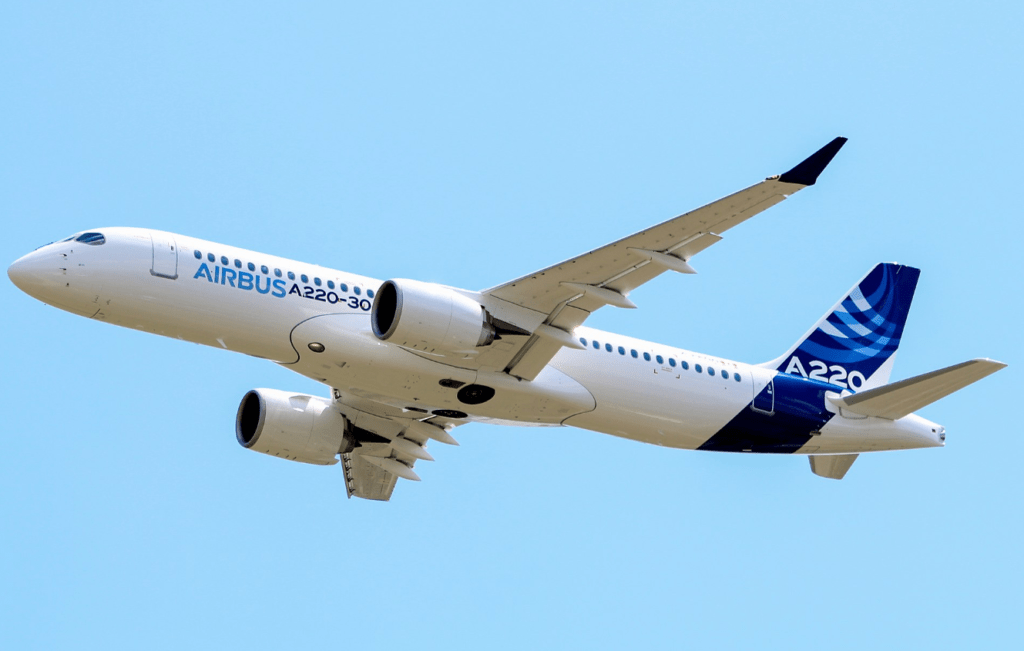
Source: Romain COUPY
Source: wikipedia
